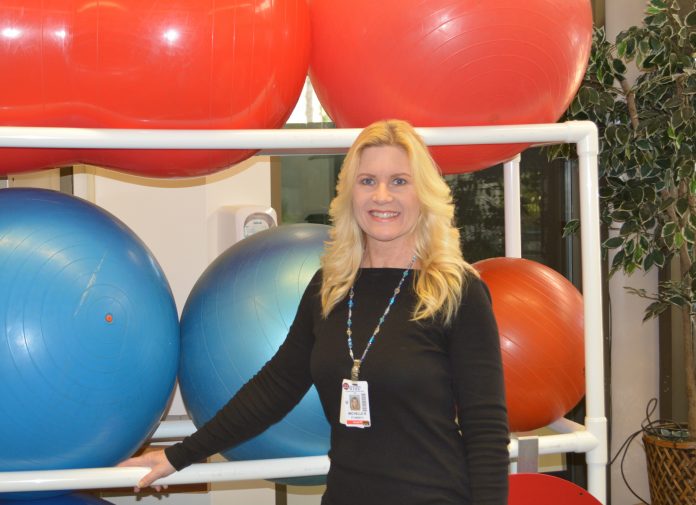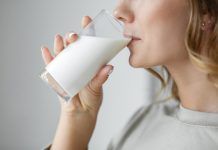
Michelle Buckley was a busy single mom raising two teenagers. As a physical therapist assistant at Sharp Grossmont Hospital, she understood the importance of keeping fit. She exercised, ate healthy food and got regular checkups.
She was also a firm believer in breast self-exams because 10 years prior, at age 32, she had found a suspicious lump on her right breast.
“That was in 2003. I had a biopsy and the diagnosis was atypical hyperplasia,” said Buckley, who has worked at Sharp Grossmont for 20-plus years helping rehab patients who have physical limitations to regain their strength and mobility.
Hyperplasia is an accumulation or mass of abnormal cells. Although her biopsy was benign, it was an abnormality that put her at higher risk for breast cancer.
“From that point on, I had a mammogram every year, and I was told that since I was young with no family history of breast cancer that I should be OK,” she said.
For most women, a mammogram is an important tool in the early detection and diagnosis of breast cancer.
However, Buckley had dense breasts, a condition common in younger women in which the breast tissue is more fibrous and there’s more glandular tissue, making it more difficult to see a mass or detect cancer with a mammogram.
Buckley didn’t know this at the time and she continued to schedule her mammograms every year. She also continued her self-exams. In 2013, she found another lump. This time, a cancerous mass was detected in her right breast.
“I really thought I might not survive because by the time my cancer was caught, I was stage three advanced, and it had spread to my lymph nodes,” she said.
“My son was 16 and my daughter was 13, and their dad had already passed away,” Buckley said.
She received the news that she had cancer on the same date their father had died two years earlier.
When asked what gave her strength during her cancer journey, she says, “My kids. They are what kept me fighting the hardest.”
Younger women at higher risk
When Buckley was diagnosed in 2013, she had no idea her cancer was caused by a gene mutation.
“There was testing for other breast cancer genes, but not PALB2; it was new. I was tested in 2017 and that’s how I found out,” she said.
About five to 10 percent of breast cancers are thought to be hereditary, caused by abnormal genes inherited from our parents.
“When Michelle was diagnosed in 2013, we knew of the more common BRCA1 and BRCA2 genes that could lead to inherited breast cancer. Now we’ve learned there are others, such as PALB2. Previously, these positive results were deemed of ‘undetermined significance,’” said Dr. David Bodkin, a board-certified medical oncologist affiliated with Sharp Grossmont Hospital.
PALB2 stands for “partner and localizer of BRCA2.” The gene interacts very closely with BRCA2. PALB2 has also recently been identified as a susceptibility gene for pancreatic cancer.
Although more research is needed, a study published in the New England Journal of Medicine suggests PALB2 may increase the risk of breast cancer in younger women. Less than 2 percent of women under age 40 are diagnosed with breast cancer, but an abnormal PALB2 gene may increase the risk by eight or nine times compared to the general population.
In addition, the study found that by age 70, PALB2 patients had a 33 percent risk of developing breast cancer, compared to 12 percent for the general population.
Risk factors and screening
The PALB2 gene mutation is rare. Dr. Bodkin says screening is done for patients who are at general risk for breast cancer as well as newly diagnosed patients, whose family history indicates the possibility of an inherited malignancy.
“The patient sees a genetic counselor who orders the blood test, looking for the gene mutation,” he said.
Buckley, however, did not have a close family connection who had breast cancer.
Generally, breast cancer risk is due to a combination of factors. Some we can control and others we cannot, such as inheriting a gene from a family member, or just being a woman and getting older. Most breast cancers occur in women age 50 or older.
Nevertheless, there are factors we can influence: not smoking, limiting alcohol, maintaining a healthy weight, being physically active and getting regular mammograms.
Buckley was diligent about her mammograms; however, her dense breasts put her at higher risk. Women who have dense breasts are four to five times more likely to develop breast cancer than those with low breast density. It’s unclear whether it’s related to the fact that mammograms with dense breast tissue are more difficult to interpret or whether more glandular tissue itself leads to increased risk.
“If you know you have dense breasts, tell your doctor,” said Dr. Bodkin. “There are other screening methods such as ultrasound and MRI. I have a number of patients alternating mammography and MRI every six months.”
Buckley also found her cancer through a self-exam, which the American Cancer Society no longer recommends as a screening tool because research doesn’t show they provide clear benefit.
Dr. Bodkin says self-exams have become somewhat controversial.
“Sometimes patients may not know exactly what they’re looking for. I’ve had many patients, including Michelle, who first detected their abnormality, so I continue to encourage them.”
Life after breast cancer: celebrate the victories
Buckley is now cancer-free. She’s taking an oral medication for the next several years to reduce her risk of the cancer recurring, but she’s healthy and doesn’t take life for granted.
“Honestly, my own patients have taught me so much about strength and resilience. As hard as my fight might have been, there are so many others going through much worse,” she said. “Having cancer taught me to never take one day for granted and not to wait for tomorrow if there’s something I can do today. It’s OK to be sad about what you’re going through, but we can sit and cry about it, or we can get up and fight our hardest, smile, laugh and help others.”
“It’s much better to celebrate our victories,” she added.
This article features experts from Sharp Grossmont Hospital. For more health stories visit www.sharp.com/news.













